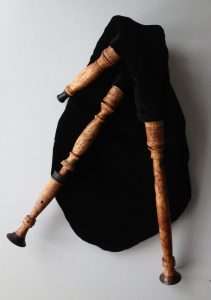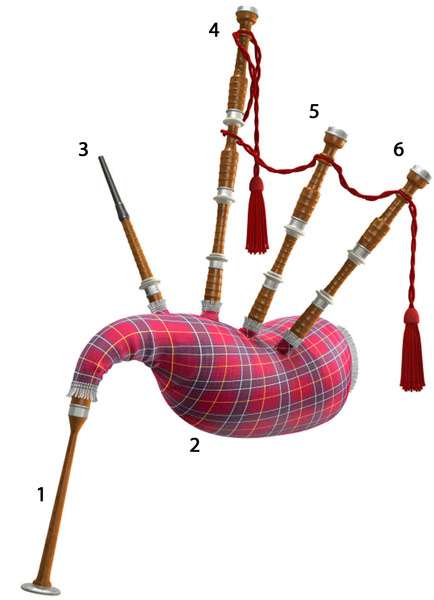
How to choose a bagpipe
Contents
The bagpipe is a traditional musical wind instrument of many peoples of Europe. In Scotland it is the main national instrument. It is a bag, which is usually made from cowhide (hence the name), calf or goat skin, taken off entirely, in the form of a wineskin, sewn up tightly and equipped with a tube on top for filling the fur with air, with one, two or three playing reed tubes attached from below, serving to create polyphony.
In this article, the experts of the store “Student” will tell you how to choose the bagpipes that you need, and not overpay at the same time.
Bagpipe device

1. Bagpipe reed
2. Bag
3. Air outlet
4. Bass tube
5, 6. Tenor reed
Cane
Whatever the appearance of the bagpipe, it uses only two types of reeds . Let’s take a closer look at these two types:
- First view– a single cane, which can also be called a single-edged or single-tongue cane. Examples of bagpipes with a single reed: Swedish sakpipa, Belarusian duda, Bulgarian guide. This cane is shaped like a cylinder that is closed at one end. On the side surface of the reed there is a tongue or, as it is also called by professionals, a sounding element. The tongue can be made separately from the reed and then tied to it. Sometimes the tongue is part of the entire instrument and is a small piece of material separated from the reed itself. When playing the bagpipe, the reed vibrates, thereby creating sound vibrations. This is how sound is produced. There is no single material from which single canes are made. It can be – reed, reed, plastic, brass, bronze and even elder and bamboo. Such a variety of materials gave rise to combined canes. For example, the body of a cane may be made of bamboo, while the tongue may be made of plastic. Single canes are easy to make. If desired, they can be made at home. Bagpipes with such a tube are distinguished by a quiet and soft sound. The upper notes are louder than the lower ones.

Swedish sakpipa
- second view– a paired cane, which can also be double or double-bladed. Examples of bagpipes with a double reed: gaita gallega, GHB, small pipe, uillean pipe. From the name itself it is clear that such a cane should consist of two components. Indeed, it is two reed plates tied together. These plates are mounted on a pin and sharpened in a certain way. There are no clear parameters for the shape of the canes or the way they are sharpened. These norms vary depending on the master and the type of bagpipe. If single canes can be made from a large amount of material, then paired canes are more capricious in this regard. A limited set of materials is used for them: Arundo Donax reed and some types of plastics. Sometimes broom sorghum is also used. In a paired cane, oscillatory movements are made by the “sponges” of the cane itself, they move because of the air passing between them. Double-reed bagpipes sound louder than single-reed bagpipes.
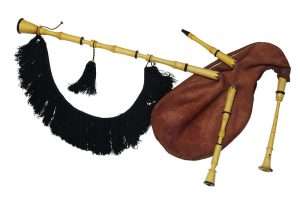
Gaita gallega
Wood is a very delicate material. It must be taken into account that each tree gives certain shades to the sound. This, of course, is good, but there are some pitfalls. The fact is that the tree requires careful handling and constant care from the musician. Keep in mind that just as no two people are the same, no two tools are exactly the same. Even two identical instruments made from the same wood will sound slightly different. Wood, like any natural material, is very fragile. It may crack, burst, or bend.
Plastic canes do not require such careful maintenance. Plastic instruments can be identical, which is why plastic is most often used by bagpipe orchestras so that the instruments sound the same and do not stand out from the general musical range. However, not a single plastic bagpipe can be compared in richness of sound shades with an instrument made of good wood.
Bag
Currently, all materials from which bags are made can be divided into natural and synthetic . Synthetic: leatherette, rubber, banner fabric, gore-tex. The advantage of bags made of synthetic materials is that they are airtight and do not require additional care. A huge disadvantage of synthetics (with the exception of the Gortex membrane fabric) is that such bags do not let moisture out. This has a negative effect on the reeds and wooden parts of the instrument. Such bags must be dried after the game. Gortex bags are deprived of this disadvantage. The fabric of the bag perfectly retains pressure, but lets water vapor out.
Natural material bags are made from animal skin or bladder. Such bags, in the opinion of most pipers, allow you to feel the instrument better, but at the same time, these bags require additional care. For example, impregnation with special compounds to maintain tightness and prevent drying of the skin. Also, these bags need to be dried after the game.
Currently, combined two-layer bags (Gortex inside, leather outside) have appeared on the market. These bags combine the advantages of synthetic and natural bags, are free from some disadvantages, and do not require special care. Unfortunately, such bags are common so far only for the Great Scottish bagpipe.
The size of the bagpipe bag can be twofold – either large or small. So, the Italian bagpipe zampogna has a large bag, and the bladder pipe has a small one. The dimensions of the bag largely depend on the master. Everyone does it at their own discretion. Even for one variety of bagpipes, the bag may differ. The exception is the Scottish bagpipe, whose bag sizes are standardized. You can choose a small, medium or large bag based on your height and build. However, not always physical data can play a decisive role in choosing the size of the bag. To choose “your” bag, you need to play the instrument, “try on” it. If the instrument does not make you uncomfortable, that is, you do not lean to the side, your hands are relaxed, then you have found your bagpipe .
Varieties of bagpipes
Great Scottish bagpipe (Great Highland Bagpipes, Piob-mhor)
The Scottish bagpipe is the most famous and most popular today. It has three bourdons (bass and two tenors), a chanter with 8 playing holes (9 notes) and a tube for blowing air. The system is from SI bimol, but with musical notation, the Highland system is designated as A major (for the convenience of playing with other instruments in America, they even began to produce versions of these bagpipes in A). The sound of the instrument is extremely loud. Used in Scottish military bands “Pipe Bands”
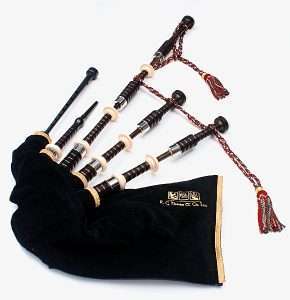
Great Scottish bagpipe
Irish bagpipe (Uillean Pipes)
The modern form of the Irish bagpipe was finally formed only towards the end of the eighteenth century. This is one of the most difficult bagpipes in all respects. It has a double reed chanter with a range of two octaves. If there are valves on the chanter (5 pieces) – full chromaticity. Air is forced into the bag by a frog (it turns out a Practice set: a bag, a chanter and a frog).
Three Uilleann Pipes drones are inserted into one drain collector and tuned in an octave relative to each other. When turned on with a special valve (stop key), they give an excellent dense sound rich in overtones. Stop key (switch) is convenient for turning off or turning on the drones at the right time in the game. Such a set is called Halfset.
There are two more holes in the collector above the drones, which in Half set are usually plugged with plugs. Tenor and baritone regulators are inserted into them. The bass control is superimposed on the side of the manifold and has its own drain.
Regulators have a total of 13 – 14 valves, which are usually closed. They sound only when the player presses them while playing with the edge of the oni fret or fingers in Slow air. The regulators look like drones, but they are actually three modified chanters with conical drilling and a double chanter reed. The entire tool assembly is called Fullset.
Uilleannpipes is unique in that a musician can extract up to 7 sounds from it at the same time. Due to its complexity, many-part and aristocracy, it has every right to be called the crowning achievement of the bagpipe idea.
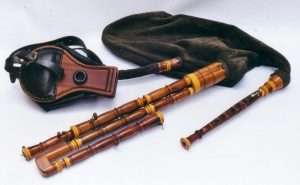
Irish bagpipe
Galician gaita (Galician Gaita)
In Galicia, there are about four varieties of bagpipes. But the Galician Gaita (Gaita Gallega) has received the greatest fame, primarily due to its musical qualities. The one and a half octave range (the transition to the second octave is carried out by increasing the pressure on the bag) and the almost complete chromaticity of the chanter, combined with the melodious and melodic timbre of the instrument, made it one of the most popular bagpipes for musicians around the world.
The instrument was widespread in the 15th and 16th centuries, then interest in it faded, and in the 19th century it was revived again. At the beginning of the 20th century there was another decline until 1970.
The fingering of the instrument is very reminiscent of the recorder, as well as the fingerings of Renaissance and medieval instruments (shawl, krumhorn). There is also an older (semi-closed) fingering called “pechado”, a cross between modern Gaita Gallega and Gaita Asturiana fingerings. Now it is hardly used.
There are three main types of Gaita bagpipes in Galicia:
- Tumbal gaita (Roucadora)
The largest gaita and the lowest in timbre , the B flat tuning, the chanter tuning is determined by closing all the finger holes except the lower one for the little finger.
There are two drones – an octave and a fifth. - Gaita Normal (Redonda)
This is a medium bagpipe and the most common. Most often it has one bass octave drone, less often two drones ( the second tenor is almost always in an octave or dominant).
There are instances with four drones bass, baritone, tenor, sopranino.
Build Up. - Gaita Grileira (Grillera)
The smallest, finest and highest in timbre (traditionally had one bass drone per octave). Build Re.
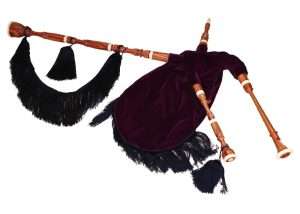
Galician gaita
Belarusian Duda
Duda is a folk wind reed musical instrument. It is a leather bag with a small “nipple” tube for filling it with air and several playing tubes that have a beep with a single tongue made of reed or goose (turkey) feather. When playing, the dudar inflates the bag, presses it with the elbow of the left hand, the air enters the tubes and makes the tongues vibrate. The sound is strong and sharp. Duda has been known in Belarus since the 16th century.

Belarusian Duda
How to choose a bagpipe



